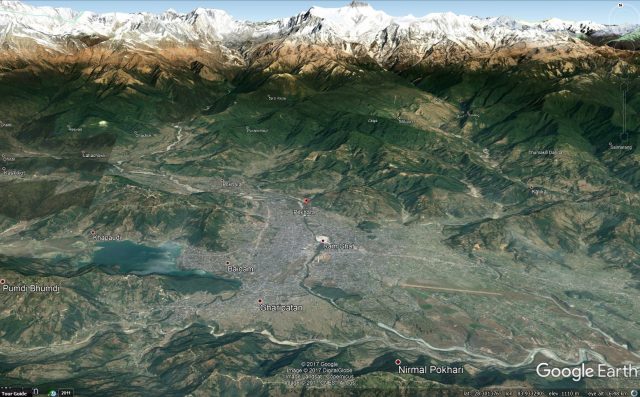8 November 2017
Evidence of catastrophic landsliding from medieval earthquakes in Nepal
Posted by Dave Petley
Evidence of catastrophic landsliding from medieval earthquakes in Nepal
Recent earthquakes in high mountain areas have generated catastrophic landsliding – in recent years I have featured examples from China, Nepal and New Zealand on this blog for example. Patterns of landsliding vary greatly though, and remain quite poorly understood. For some years there has been evidence that far more catastrophic landsliding than this might have been associated with past earthquakes in Nepal, as evidenced by huge valley fills in the Pokhara basin, part of the Seti Khola gorge. This is the site of the huge landslide and debris flow of a few years ago that we analysed here, but these landslides would have been on a far greater scale. In recent years this record of historic landsliding has slowly been unpicked and analysed, and a paper just published in Quaternary Science Reviews (Stolle et al. 2017) provides new insight.
The basis of the work is a huge (148 km²) fan in the vicinity of the town of Pokhara below the Annapurna Massif, which has inundated 15 tributary valleys. This fan can be seen in the Google Earth image below. There are older valley fills in the Pokhara basin, so the events uncovered by this research may not be unique. The team have mapped and logged the stratigraphy of these deposits, and they have dated them extensively. They have found that the deposits represent three pulses of sediment delivery from the mountains, dated at around 1100 AD (providing sediments that are up to 25 m thick, representing a volume of about 1.9-3.3 km³ of sediment), 1255 AD (2.9-3.7 km³) and 1344 AD (0.3-0.5 km³).

Google Earth image of the Pokhara area, with the Annapurna massif behind. The town is built on the huge fan deposit that resulted from catastrophic landsliding generated by three medieval earthquakes.
.
Stolle et al. (2017) interpret these deposits as being the geomorphic legacy of earthquake-driven sedimentation. They consider that each of these three deposits was the result of a large earthquake, each of which generated huge debris flows that, as they put it, invaded and plugged the tributary valleys, allowing lake deposits to form. There is evidence from archive sources of two of these large earthquake events. What is not clear as yet is the source of these huge debris flows – were they massive rockslope failures that transitioned into channelised debris flows on an epic scale, or were they triggered by the collapse of valley-blacking landslide dams or suchlike? This will require fieldwork in the high mountains, an environment in which it is very hard, and very expensive, to work.
Stolle et al. (2017) note that these huge deposits are essentially unique to this area of Nepal at present – similar scales of deposits have not been identified elsewhere as yet. But they do suggest that earthquakes have the potential to generate catastrophic landsliding on a scale far greater than we have observed to date, which of course has important implications for our analysis of hazard.
Reference
Stolle, A., Bernhardt, A., Schwanghart, W., Hoelzmann, P., Adhikari, B.R., Fort, M. and Korup, O. 2017 Catastrophic valley fills record large Himalayan earthquakes, Pokhara, Nepal. Quaternary Science Reviews, 177, 88–10


 Dave Petley is the Vice-Chancellor of the University of Hull in the United Kingdom. His blog provides commentary and analysis of landslide events occurring worldwide, including the landslides themselves, latest research, and conferences and meetings.
Dave Petley is the Vice-Chancellor of the University of Hull in the United Kingdom. His blog provides commentary and analysis of landslide events occurring worldwide, including the landslides themselves, latest research, and conferences and meetings.